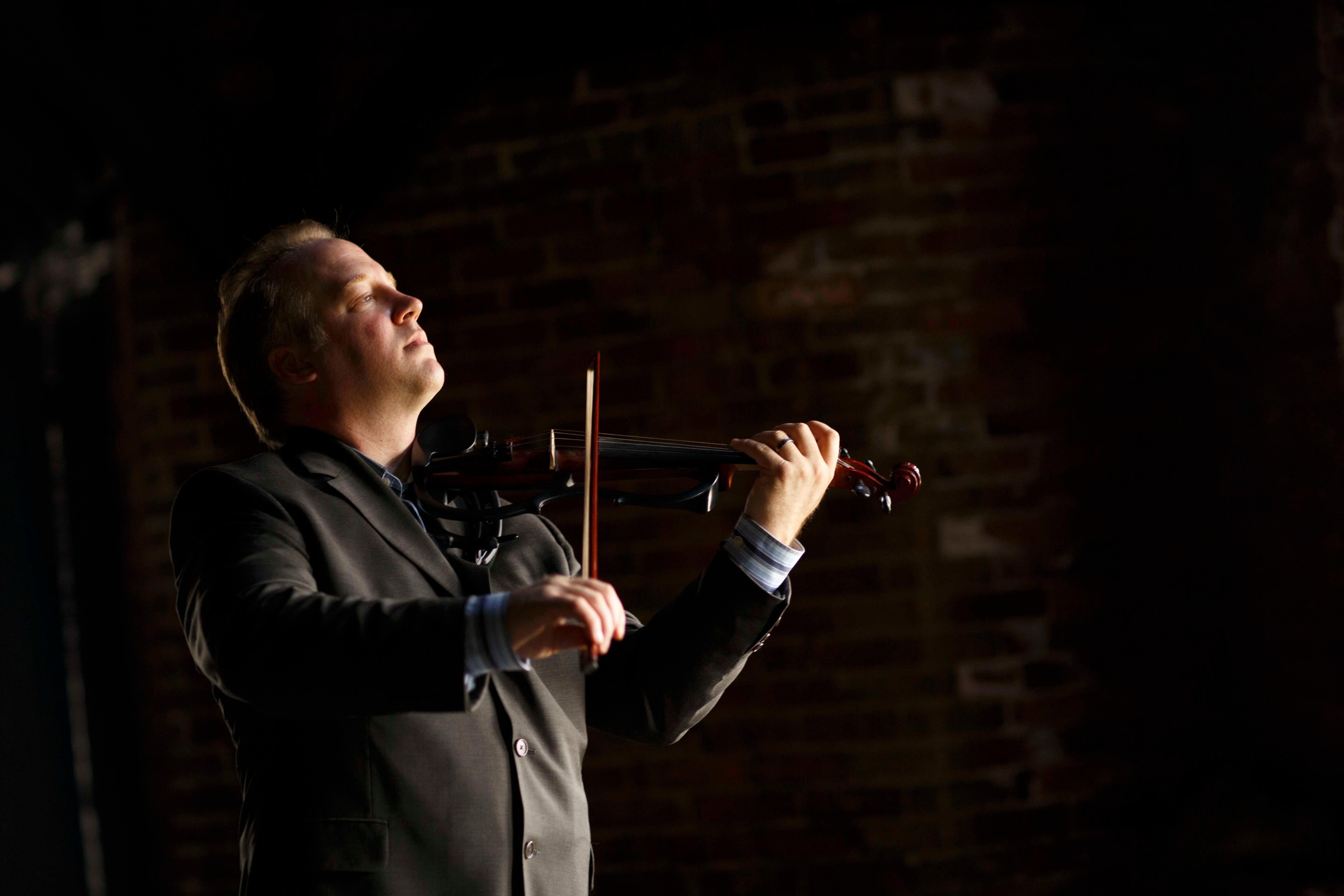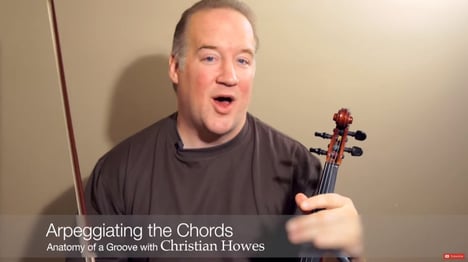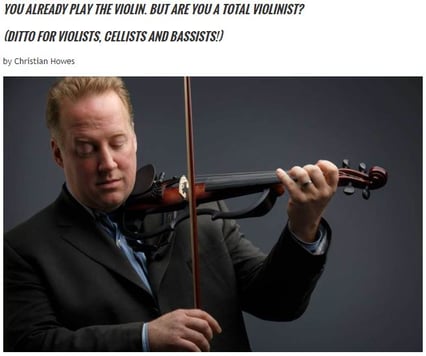
In his last SHAR blog post, Christian Howes introduced us to his Creative Strings Academy and the pedagogy that he developed especially for string players. In this new article, Christian shares the lessons of a master.
This well-known violin partita has been modified from its original version! Can you name this partita?
In my first post of this series I suggested four ideas- pillars as a way forward to think about how to best help string players become more broadly functional and creative, beyond their classical training;
1) Demystifying Musical Construction and Making “Theory” Practical
2) Creativity and Self-Expression
3) Multicultural Approach - Exposure to a broader array of genres and approaches to music making.
4) Advocacy for the Proliferation of Music in our Communities
If you missed it, feel free to read the full article before moving on.
If any of the following apply to you, you likely are looking to become a total string player:
- You want to develop comfort or mastery in improvisation, composition, and arranging.
- You want to become creatively self-expressed and develop your distinctive musical voice.
- You want to internalize harmony, voice-leading, scales, modes, and be able to apply them.
- You want to become fluent in contemporary styles so you can jam with a church band, drum circle, indie rock band, jazz ensemble, bluegrass session, create YouTube covers, etc…
- You want to be able to use amplification and effects.
- You want to get a wider variety of gigs
- Teachers: You want age-appropriate sequences to add to your bag of tricks.
Creative Strings helps string players acquire these skills through our Online Membership (academy), unique digital resources, outreach in schools, and annual conferences.
Presenting this information in a sequential fashion has been the central challenge of my work the past 20 years. And much of this information is already commonly known in other musical communities, whether the now-academic community of Jazz studies or the more participatory worlds of Appalachian music, the African American church, or rock musicians.
There's another obstacle, beyond presenting this information, related to the high level of expertise most classical musicians have. This very expertise leads to a psychological obstacle in internalizing new skills connected to improvisation, contemporary styles, and related subjects.
Think of This in Two Ways. . .
1) Fast thinking vs Slow Thinking
If you ever try to play your violin left handed, you will experience the phenomenon known as slow thinking. (Try it! You'll be lucky to play Twinkle in tune.)
Pick up the instrument again in right handed position, and you'll observe yourself thinking fast. Fast thinking is something which takes over in any situation in which we have developed mastery. And almost every violinist who has studied for several years has developed levels of mastery, so much so, that they aren't even aware of it (until they try the left handed experiment above).
Learning to improvise, to internalize chords and scales, or a new genre like blues, sets in motion a slow process of learning from scratch, almost as if you were learning the violin left handed.
This is a very simple way of looking at the problem, i.e. you will be learning new skills, new information, and new mindsets - all of which will cause you to need to slow down the rate at which you internalize information and skill. (A very popular book on this subject "Thinking, Fast and Slow" by Daniel Kahneman, came out a few years ago and it resonates.)
Many classical musicians presume that improvisation or contemporary styles will not be this drastic of a new beginning, and they are frustrated and perplexed by the need to slow down. Your expertise as a violinist and your expertise as a classical musician will only overlap in some ways, but they are limited.
2) This brings me to my second point, the psychological ramifications of beginning in a new realm of musical studies.
Most of us started at a young age on the violin, and most of us, over time, were told how amazing it is that we could be such experts at such a difficult instrument. It's true; We developed deep levels of expertise playing chamber music, sitting in orchestra, and analyzing the endless technical and musical nuances of concerti.
Through this we also came to have more than just pride in our ability. We came to rely on it for a part of our self-image, and perhaps even our self-esteem. To be confronted by a musical problem that is foreign or confounding can be felt almost as if it is an attack on our very self-image.
To experience what it is to be a novice is a very vulnerable space, especially for the most expert among us. This is why I often see the most elite players and teachers experience resistance when asked to venture into these new territories. Their confidence is based on the knowledge that they are experts, and facing something unknown in the realm of music feels unbearably scary. It often results in tears.
Compartmentalization is Key
Doctors, Attorneys, Scientists, Chefs, Athletes, and Business people all specialize. It is important to recognize the areas within music for which you are an expert, and similarly recognize areas which are foreign or unknown. Once you articulate the things which are unknown in compartmentalized fashion, you can begin step by step to address these new skills.
Let yourself off the hook. Let go of the assumption that because you have a good ear, or because you have good technique, that these will automatically transfer into being able to learn another style or become an expert immediately in arranging, improvisation, or composition.
Since I grew up as a Suzuki kid and later went on to refined finishing teachers, camps, chamber, orchestral, and conservatory experiences, I learned these lessons the hard way. I doubted myself often and long.
For over 20 years I've worked to develop the Creative Strings Academy curriculum with this in mind, sharing the lessons I learned so others in my position could avoid the mistakes of trial and error I made.
Dip Your Toe in the Water!
1) Try some of the distinct books, resources, and courses available at Shar
2) Sign up for a Free 30-day trial of Creative Strings Academy. Included in your trial will be FOUR immediate downloads of my most popular ebooks, AND, as a special promotion this month, you can schedule a free private Skype lesson with me (subject to availability.
3) Watch these videos!

Here's a full PLAYLIST with steps you can take to practice and master a simple improvisational groove
Here’s an ear training challenge- See if you can play back the "licks" you hear on this video. When I grew up playing Suzuki, I was proud of my ability to "play back" all the classical melodies I heard, and it came as a shock when I realized there were some melodies in other styles that were more difficult for me to do this with. Go ahead- get out your instrument and see how you do!
Funky Groove technique for violinists (Beyond "chopping"). Many classical violinists ask me to explain the "technique" of chopping. This misses the point. Learning the technique of a specific chop is a classical way of thinking about the problem. This video explains the mindset and rational behind grooving on violin. Let me know what you think in the comments beneath this post!



